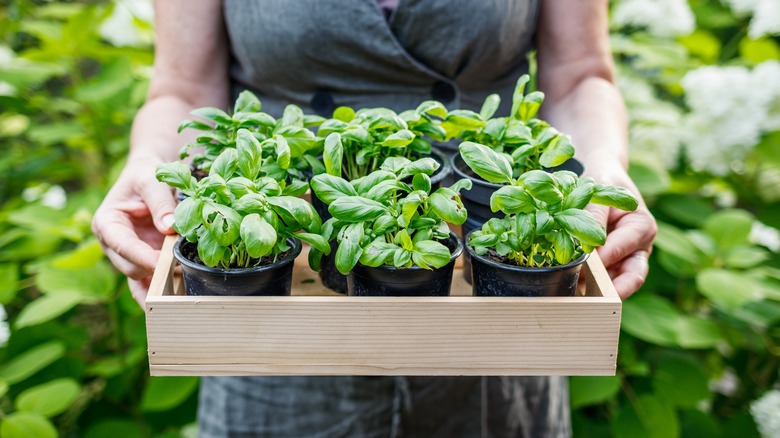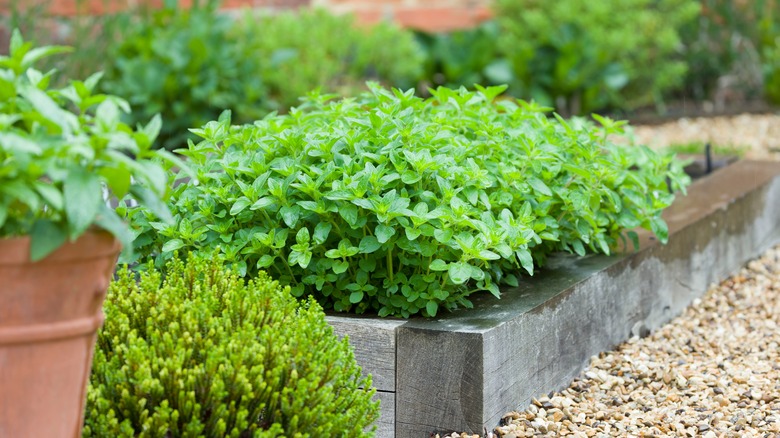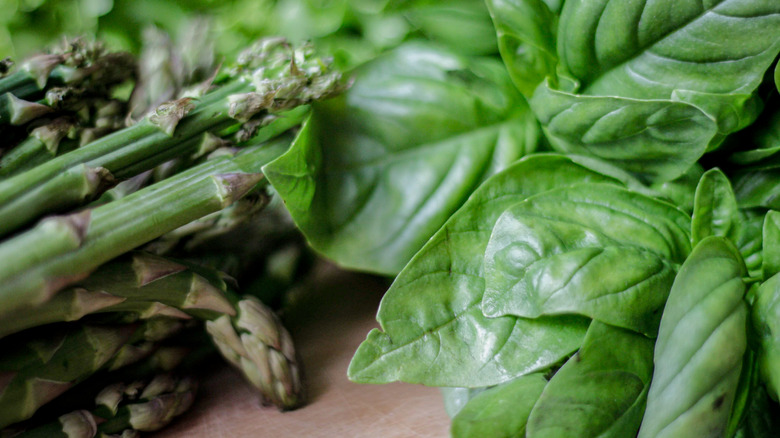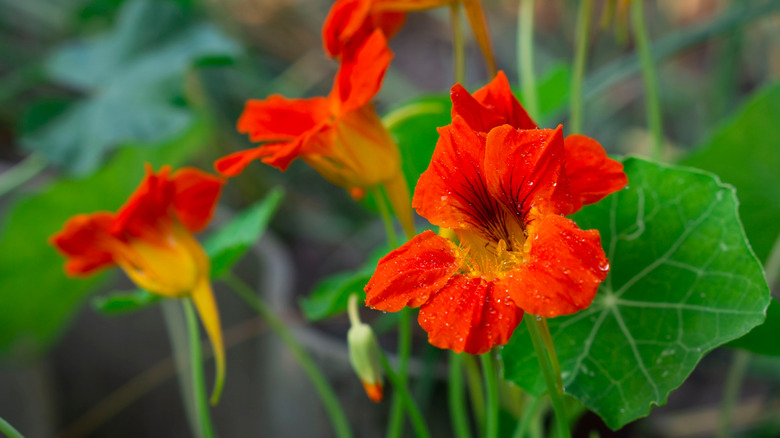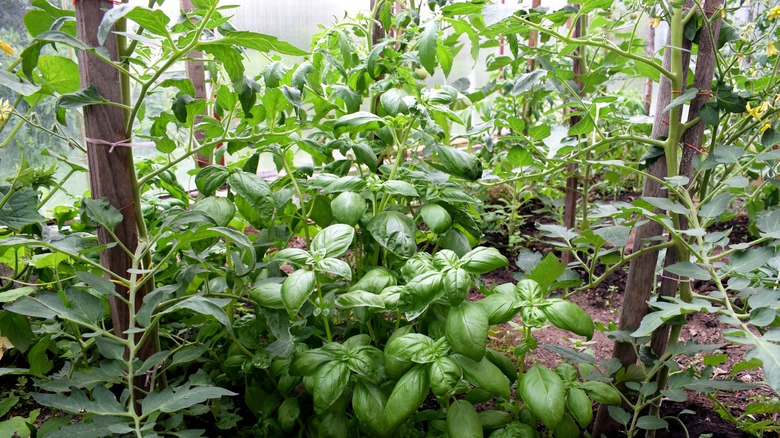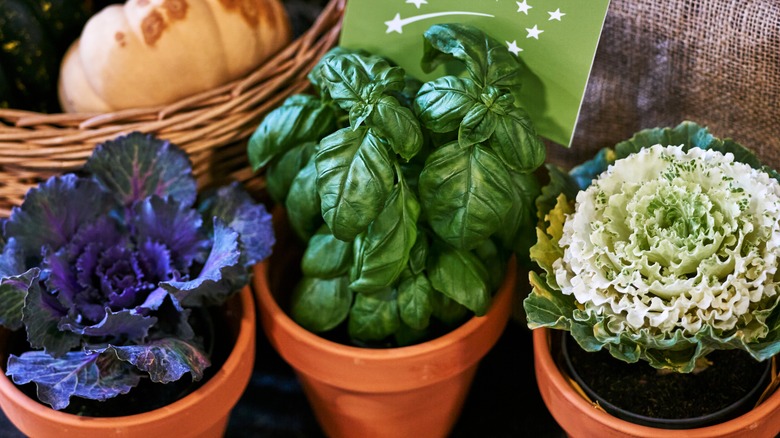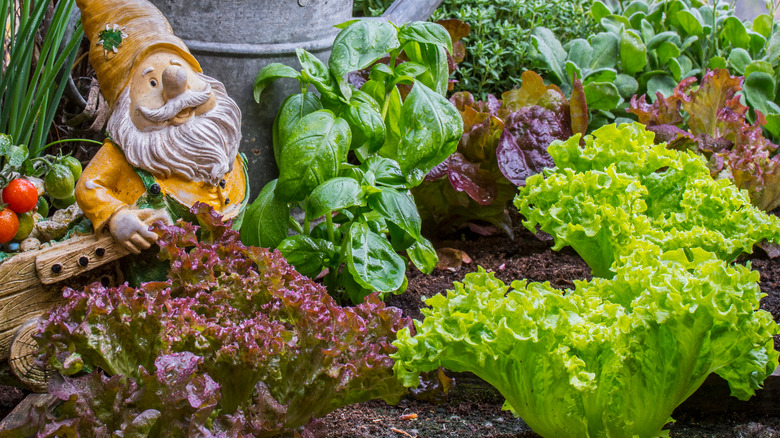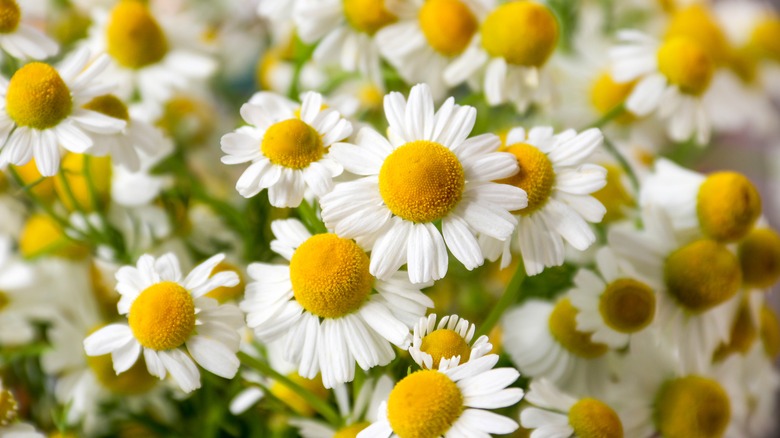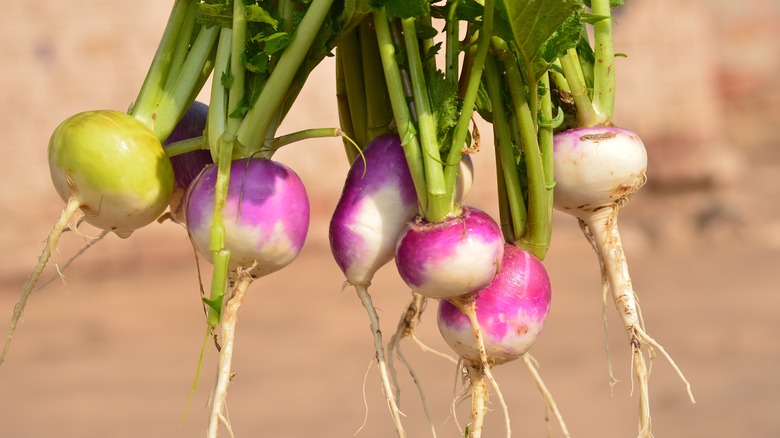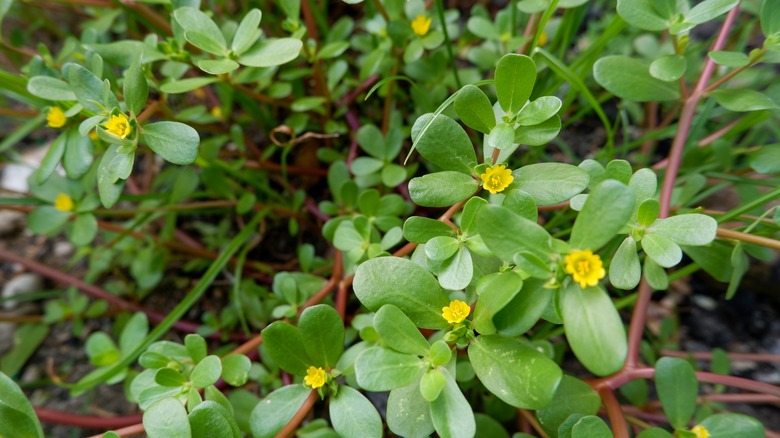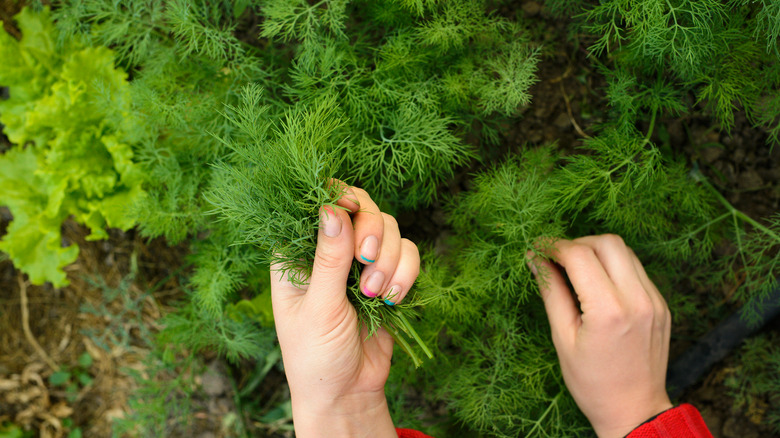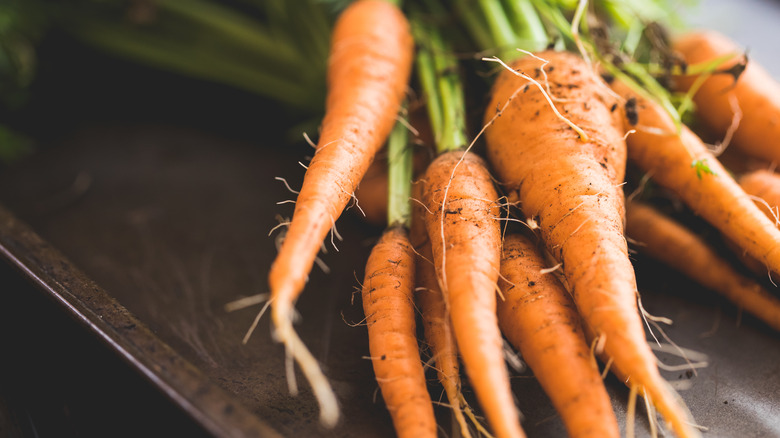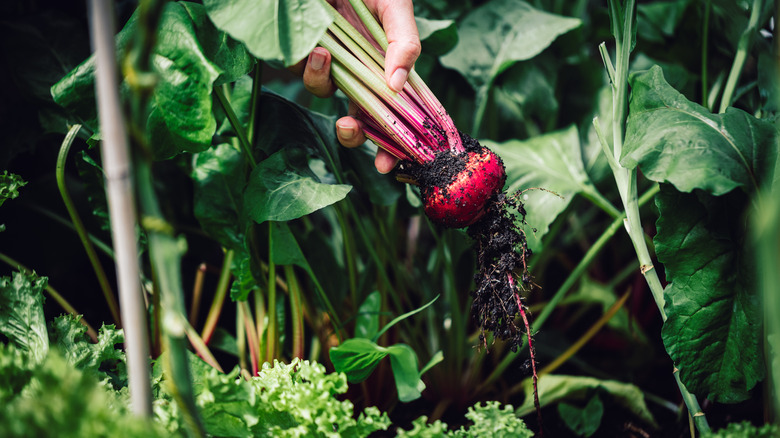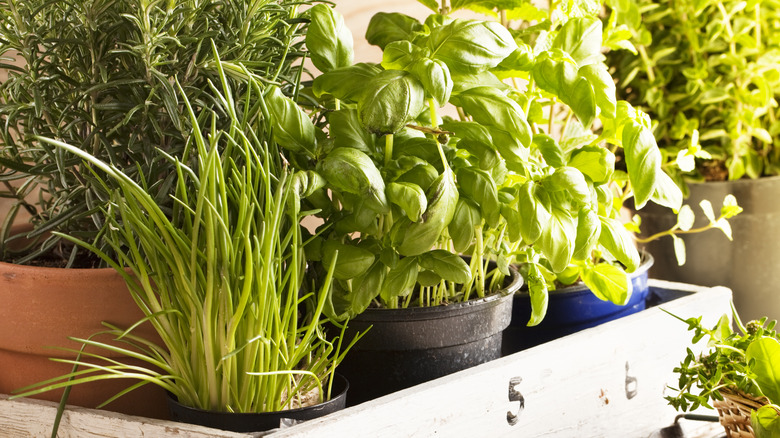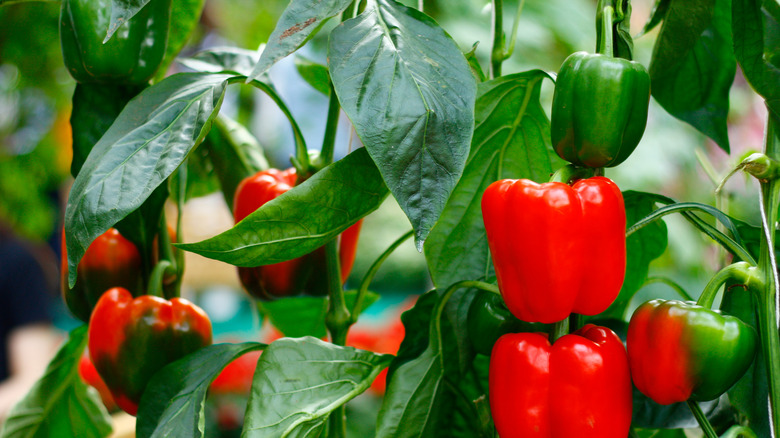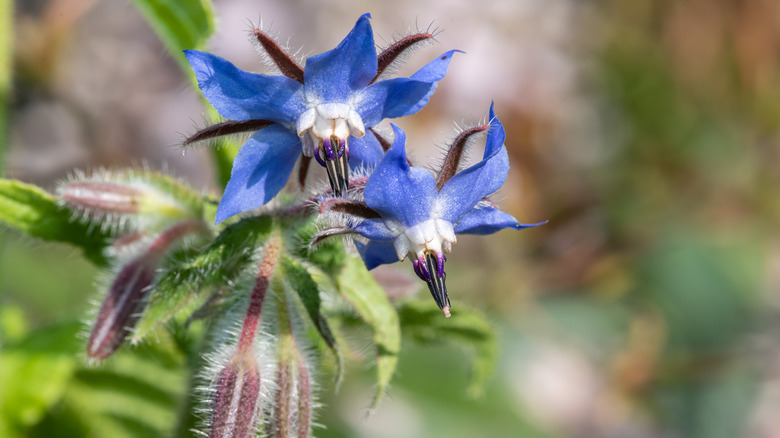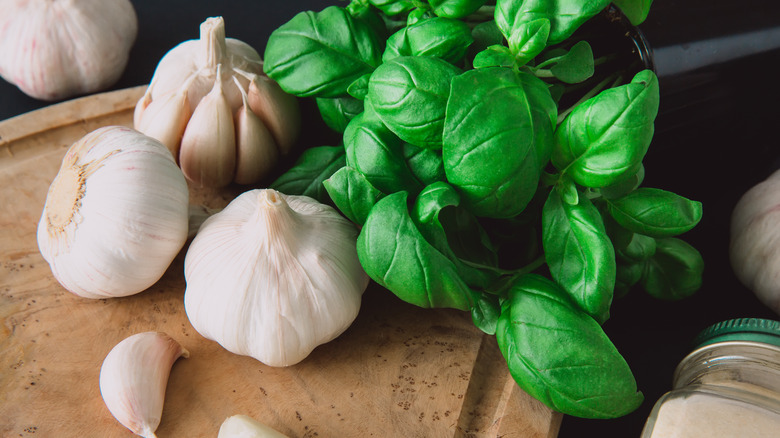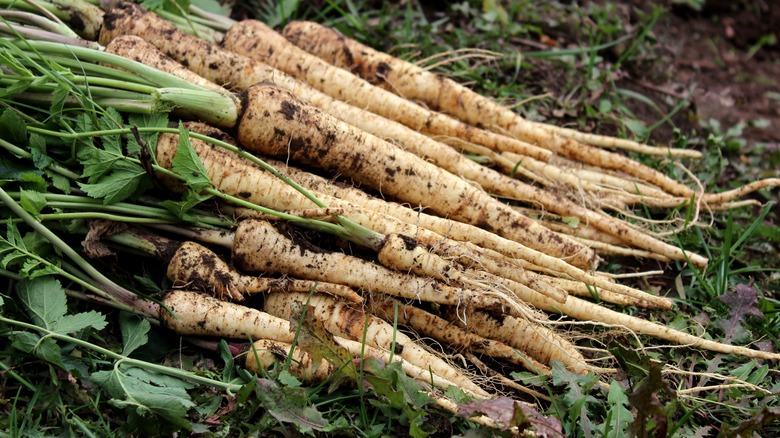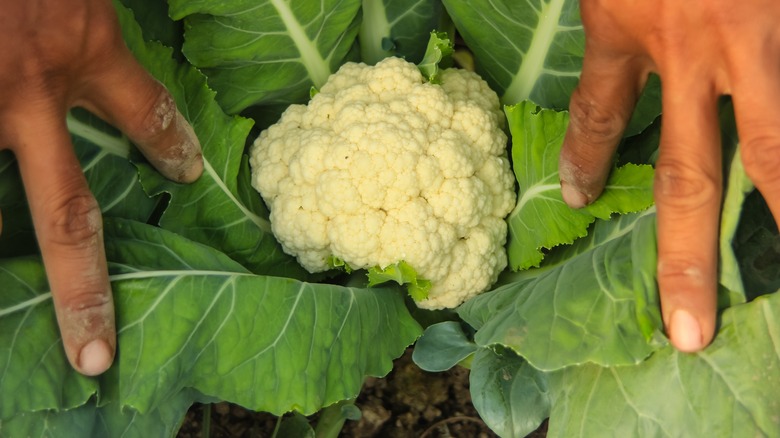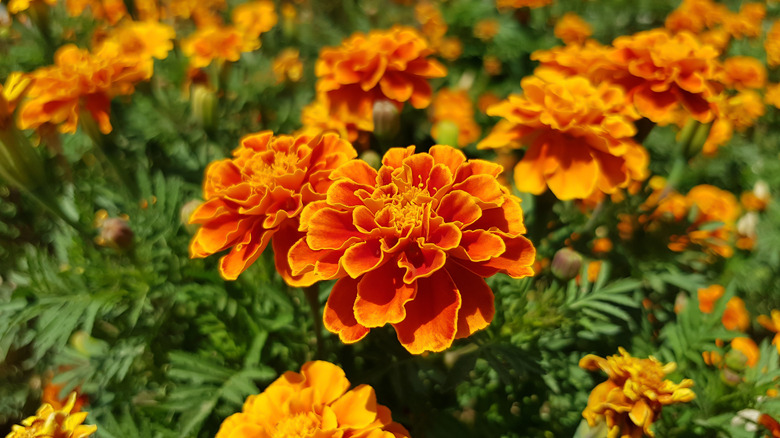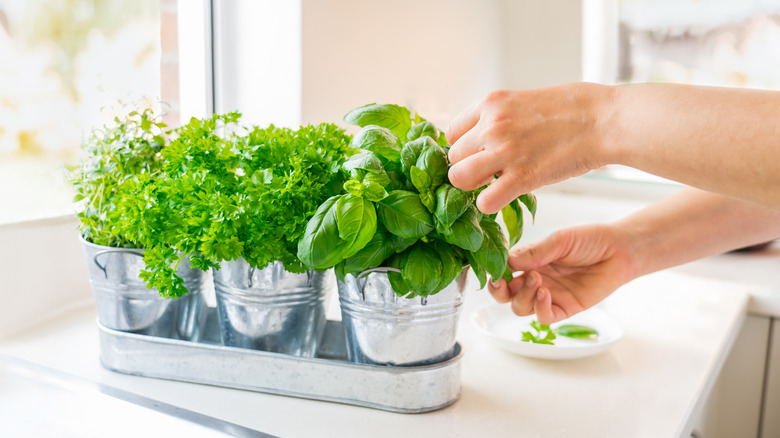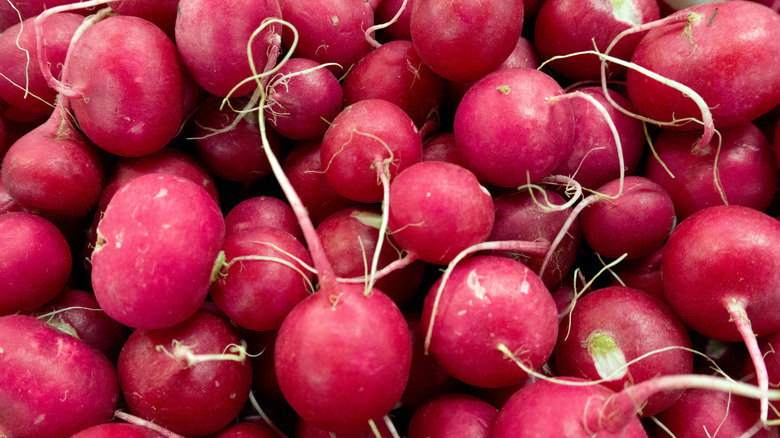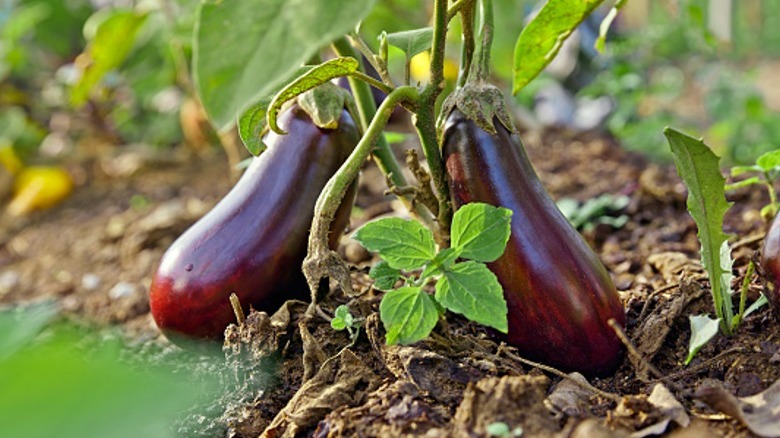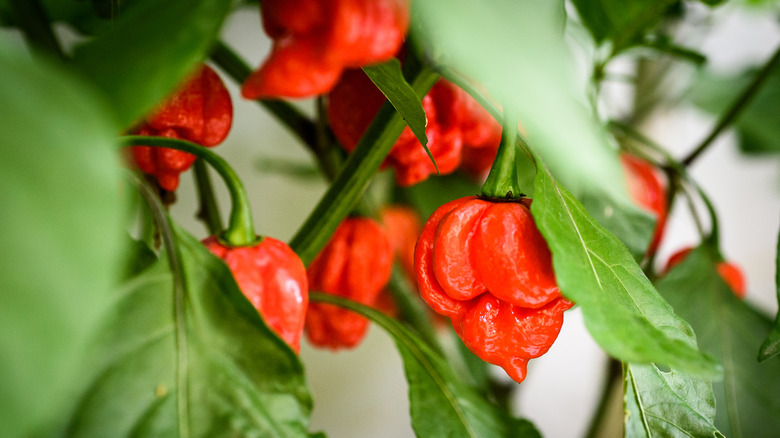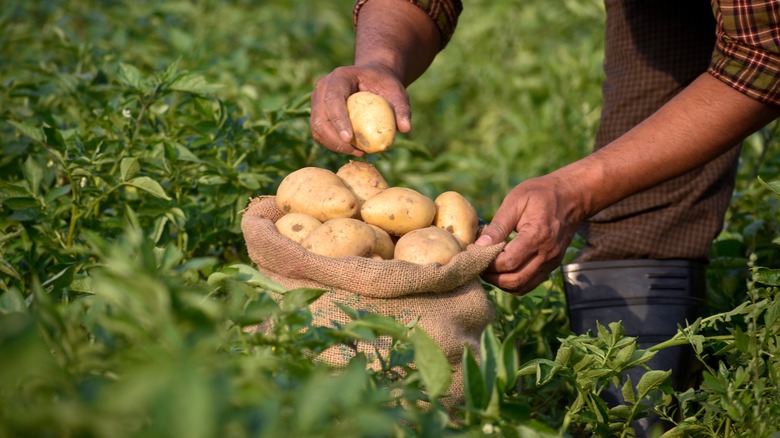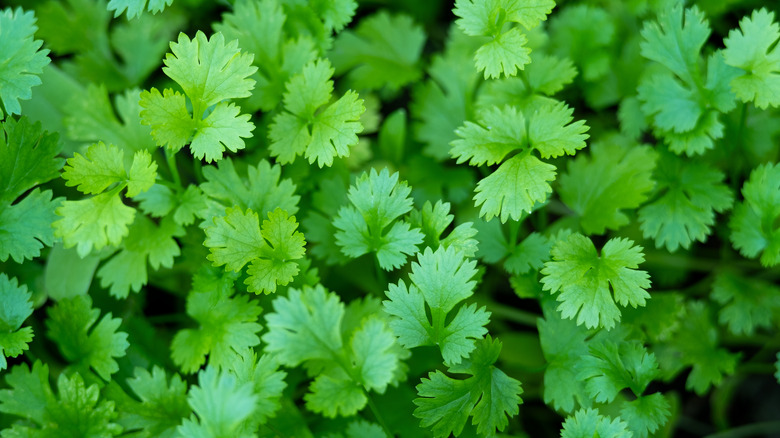Companion Plants That Will Thrive Alongside Basil In The Garden
The basil plant (Ocimum basilicum) is popular in home gardens for its delicious leaves that have several uses in the kitchen. This herb, which is frequently used to flavor pasta, beef, and fish dishes, is one of the best companion plants out there. It has many friends in the plant kingdom and forms relationships with a variety of vegetables, flowers, and other herbs that could use some help during their growing season.
One of the reasons that basil makes a good companion plant is that its soil preference is the same as many other edible plants. It enjoys moist, rich, and well-draining garden soil that helps it produce the large and flavorful foliage we love. Additionally, its scent and flowers attract beneficial insects that will pollinate nearby plants while also repelling harmful bugs that snack on more palatable species like tomatoes and cabbage.
However, these basil companions aren't taking advantage of the culinary herb. They're helping in their own way. Borage, for example, is reported to enhance basil plants' flavor and growth when planted nearby. Companion planting with basil has even more benefits than this. Check out our collection of plants you can grow alongside it to watch your herb and vegetable gardens thrive.
1. Oregano
Though basil isn't great for growing alongside every herb, oregano (Origanum vulgare) can make for a good companion plant. By planting the two together, you allow both herbs to improve each other's pungent foliage for a more intense flavor. Not only does this trick work to give you a better-tasting harvest, but it also makes basil more effective at driving away harmful insects.
Bloom Season: Summer to fall
USDA Growing Zone: 4 to 8
Growing Conditions: Full sun
Soil Type: Well-draining
Size: 1 to 3 feet tall and wide
2. Asparagus
Asparagus (Asparagus officinalis) and basil are a great example of a mutually beneficial relationship between two companion plantings. When they are grown together, asparagus attracts ladybugs which are beneficial insects that feed on harmful aphids. At the same time, the smell of basil plants' leaves keeps asparagus beetles away, which eat the vegetable's foliage.
Bloom Season: Insignificant flowers in spring and summer
USDA Growing Zone: 3 to 10
Growing Conditions: Full sun
Soil Type: Organically rich and well-draining
Size: 3 to 4 feet tall and 1 to 2 feet wide
3. Nasturtiums
Though nasturtiums (Tropaeolum spp.) and basil aren't necessarily companion plants to one another, they can be planted together to protect other species in your garden. Nasturtiums are known for their fragrant flowers that lure in aphids and squash bugs. This keeps the feasting insects from eating other plants, but the blooms also bring in reinforcements. Aphid-eating pollinators and flies are attracted by nasturtiums and basil to make sure the harmful insects stay gone.
Bloom Season: Summer to fall
USDA Growing Zone: 2 to 11
Growing Conditions: Full sun
Soil Type: Well-draining
Size: 1 to 10 feet tall
4. Tomato
Tomatoes (Solanum lycopersicum) and basil are among the most well-known companion plant pairs. The two cohabitate in garden beds nicely as they help one another become healthier and more delicious. Because of basil's pungent smell, it can ward off insects harmful to the fruiting plant, and it attracts pollinators that contribute to the tomato's yield. Tomatoes are said to aid in the growth and flavor of the basil plant too.
Bloom Season: Summer
USDA Growing Zone: 10 to 11
Growing Conditions: Full sun
Soil Type: Well-draining
Size: 3 to 6 feet tall and 2 to 3 feet wide
5. Cabbage
Cabbage (Brassica oleracea var. capitata) is a member of the same family as broccoli, cauliflower, brussels sprouts, and kale. And, like many of these related vegetable plants, cabbage needs full sun and rich soil with some moisture. Grown beside one or more basil plants, cabbage becomes more protected against its worst pest, such as cabbage worms and aphids.
Bloom Season: Rarely flowers
USDA Growing Zone: 2 to 11
Growing Conditions: Full sun
Soil Type: Rich, moist, and well-draining
Size: 1 to 2 feet tall and wide
6. Lettuce
Lettuce (Lactuca sativa) is a fantastic companion plant for basil. Like with our tomatoes, the two are thought to enhance each other's natural flavor and growth habits. Growing them together can result in bigger and tastier foliage that makes your garden's fresh meals even better. Both leafy plants should be cared for in a bed or container filled with fertile and well-draining soil that is kept reasonably moist.
Bloom Season: Summer
USDA Growing Zone: 2 to 11
Growing Conditions: Full sun to partial shade
Soil Type: Fertile and well-draining
Size: 6 to 12 inches tall and wide
7. Chamomile
The chamomile plant (Matricaria chamomilla) is recognized for its scented flowers that are commonly brewed in hot water to make a soothing tea. The blooms, which look quite similar to daisies, can also be used as a pest deterrent, like basil. Planted together, the two herbs won't only keep threatening insects out of your garden. Likely, the two will also enhance each other's scent, flavor, and overall health.
Bloom Season: Summer and fall
USDA Growing Zone: 2 to 8
Growing Conditions: Full sun to partial shade
Soil Type: Well-draining
Size: Up to 30 inches tall
8. Turnips
Another member of the Brassica genus, turnips (Brassica rapa subsp. rapifera), are typically grown in sunny parts of the garden that offer well-draining and fertile soil that is regularly watered. On their own, turnips are good at deterring some common pests, but they welcome the help of aromatic plants like basil to protect their tender foliage.
Bloom Season: Summer
USDA Growing Zone: 3 to 10
Growing Conditions: Full sun to partial shade
Soil Type: Loamy, fertile, and well-draining
Size: 12 to 24 inches tall and 6 inches wide
9. Purslane
Purslane (Portulaca oleracea) can actually help basil more than basil can help it. The relatively low-growing and drought-tolerant plant may be placed beneath your basil plant to protect the soil from the hot summer sun. By keeping its soil moist and cool, basil benefits from purslane's mat-like habit as it stays fresher and healthier during the growing season.
Bloom Season: Spring to fall
USDA Growing Zone: 2 to 11
Growing Conditions: Full sun
Soil Type: Evenly moist and well-draining
Size: Up to 16 inches tall and 3 feet wide
10. Dill
Dill (Anethum graveolens) and basil don't just work together when they've been made into a mouth-watering basil dill pesto, they also grow well together when planted in the same container. The two herbs both enjoy rich soil that receives frequent watering and mild outdoor temperatures. If you're growing a larger herb garden, consider adding cilantro and chives to the mix to see how they thrive in the shared space.
Bloom Season: Summer
USDA Growing Zone: 2 to 11
Growing Conditions: Full sun
Soil Type: Rich and well-draining
Size: 1 to 4 feet tall
11. Carrots
Carrots (Daucus carota var. sativus), as well as a handful of other root vegetables, are a good option for planting nearby basil plants. The orange veggie is susceptible to a variety of pests such as carrot rust flies, wireworms, and leafhoppers. Thankfully, basil is known to fight off several species of harmful flies, beetles, and more that threaten the carrot plant's health as they snack on fresh foliage.
Bloom Season: Summer
USDA Growing Zone: 2 to 11
Growing Conditions: Full sun
Soil Type: Loose, fertile, and well-draining
Size: 3 inches to 3 feet tall and wide
12. Beets
Basil continues to be a good partner for root vegetables, like beets (Beta vulgaris), that are threatened by soil-boring insects eating their foliage. Planted above the tuberous roots, the smelly herb can repel beet pests. Beets can also be grown with other basil companion plants like lettuce, radishes, and cabbage. Consider growing the vegetables together interplanted with basil to deter pests and attract beneficial insects.
Bloom Season: Does not flower
USDA Growing Zone: 2 to 11
Growing Conditions: Full sun to light shade
Soil Type: Moist, organically-rich, fertile, and well-draining
Size: 1 to 2 feet tall and wide
13. Chives
Chives (Allium schoenoprasum) are often planted in herb gardens alongside basil, oregano, and other leafy plants that enjoy full sun and plenty of moisture in their well-draining soil. As a member of the Allium genus, chives have a distinct and strong scent that rivals basil. Grown together, the odor of the two plants keeps harmful insects away from both herbs and others growing nearby.
Bloom Season: Spring and summer
USDA Growing Zone: 3 to 9
Growing Conditions: Full sun
Soil Type: Rich and well-draining
Size: 12 to 18 inches tall and 12 to 18 inches wide
14. Sweet peppers
Sweet peppers (Capsicum annuum) are among the best plants on this list for pairing with basil. The two of them are frequently recommended for growing together because of their nearly identical growing requirements. In addition to this, however, basil is the star of the show once again, as it dissuades harmful insects and elevates the taste and vitality of the sweet pepper plant.
Bloom Season: Summer
USDA Growing Zone: 4 to 11
Growing Conditions: Full sun
Soil Type: Well-draining
Size: 1 to 4 feet tall and 6 to 12 inches wide
15. Borage
Borage (Borago officinalis) and basil plants grow well together for a few different reasons. For one, they attract many of the same insects, namely pollinators, that may help to increase the health of much of your garden. Another reason is that they are both edible. Keeping borage alongside basil and other herbs like dill and parsley makes harvesting simple. Finally, they also like to grow in the same kind of conditions.
Bloom Season: Spring and summer
USDA Growing Zone: 2 to 11
Growing Conditions: Full sun to light shade
Soil Type: Well-draining
Size: 1 to 3 feet tall
16. Garlic
Planted close to one another, garlic (Allium sativum) and basil are said to concentrate their respective flavors. But the two should be planted together for more than just this. Like chives, garlic is a member of the pungently scented Allium genus. So, when planted in tandem with basil, both of them enhance your garden's production by attracting the bugs you want and repelling the ones you don't.
Bloom Season: Spring
USDA Growing Zone: 7 to 10
Growing Conditions: Full sun
Soil Type: Organic and well-draining
Size: Up to 3 feet tall
17. Parsnips
Parsnips (Pastinaca sativa), which are a close relative of carrots, can also benefit from being planted near basil. The low-maintenance root vegetable grows in moist soil and direct sunlight, much like the herb, so they end up being good partners. During the warmest parts of the season, a basil plant can protect parsnips from carrot flies that are repulsed by the smell of its leaves.
Bloom Season: Summer
USDA Growing Zone: 2 to 9
Growing Conditions: Full sun to partial shade
Soil Type: Moist and well-draining
Size: 1 to 5 feet tall
18. Cauliflower
Cauliflower (Brassica oleracea, Botrytis Group) is susceptible to damage and disease from a variety of insects that seek out its tender leaves. The best way to keep these bugs away before harvest time is to grow trap plants and insect-repelling plants that will distract them or fend them off. In addition to garlic, nasturtium, and a few pungent herbs, basil can help to deter cabbage worms and more common pests.
Bloom Season: Spring to fall
USDA Growing Zone: 2 to 11
Growing Conditions: Full sun
Soil Type: Moist and loamy
Size: 1 to 2 feet tall and wide
19. Marigolds
Marigold flowers (Tagetes patula), like basil plants, are grown in gardens to fend off damaging insects such as nematodes, aphids, beetles, and slugs. One trick involves growing basil and marigolds together. By pairing up the two, they can keep harmful insects away without the use of pesticides. The flowering plants also attract beneficial insects that help both of the companions as well as herbs and veggies growing nearby.
Bloom Season: Spring to fall
USDA Growing Zone: 2 to 11
Growing Conditions: Full sun to partial shade
Soil Type: Well-draining
Size: 6 to 12 inches tall and wide
20. Parsley
Parsley (Petroselinum crispum) and basil just make sense together in the garden. The two herbs both need full sun as well as rich and well-draining soil that is kept moist to survive. When they are planted in the same container or garden space, the two team up to intensify each other's flavors and scent while also deterring insects such as asparagus beetles and attracting essential pollinators.
Bloom Season: Summer
USDA Growing Zone: 3 to 9
Growing Conditions: Full sun
Soil Type: Rich and well-draining
Size: 12 to 18 inches tall
21. Radishes
A well-known root crop, the radish (Raphanus sativus), is a member of the Brassica family. And, like many of its relatives, it can benefit from basil's ability to scare off some of its worst pests. Carrot flies and flea beetles both threaten radishes' well-being, but they are driven away by the scent of the pungent basil leaf. Other good companion plants for radishes include chervil, nasturtium, and lettuce.
Bloom Season: Spring
USDA Growing Zone: 2 to 11
Growing Conditions: Full sun
Soil Type: Well-draining
Size: 2 to 3 feet tall and 1 to 2 feet wide
22. Eggplant
Eggplants (Solanum melongena) and basil plants get along so well because the former is frequently targeted by the same pests as tomatoes. Flea beetles, tomato hornworms, and tobacco hornworms are some of the worst of them. However, basil repels all of these bugs to varying degrees. When both plants are grown in fertile and moist soil with plenty of sunlight, the two of them will help each other flourish.
Bloom Season: Spring and summer
USDA Growing Zone: 9 to 12
Growing Conditions: Full sun
Soil Type: Fertile, moist, and well-draining
Size: 1 to 4 feet tall and wide
23. Ghost pepper
Ghost peppers (Capsicum chinense) have fairly simple growing requirements. They need direct sunlight, warm temperatures, and moist but well-draining garden soil. Coincidentally, these are the same conditions that basil plants enjoy as well. Capsicum species and the culinary herb also aid in each other's overall health. Basil repels many pests of ghost peppers, and the pepper plant reportedly makes nearby basil plant leaves more flavorful.
Bloom Season: Summer
USDA Growing Zone: 10 and 11
Growing Conditions: Full sun
Soil Type: Rich, moist, and well-draining
Size: 12 to 30 inches tall and 12 to 24 inches wide
24. Potatoes
Potato plants (Solanum tuberosum) grow well next to basil because of the herb's knack for repelling potato bugs, also known as the Colorado potato beetle. The striped pests are a major threat to potato plants as they lay eggs that become larvae and eat the crop's leaves. By simply planting a few basil plants nearby your potatoes, you can keep potato beetles away without using pesticides or similar methods of pest control.
Bloom Season: Summer and fall
USDA Growing Zone: 2 to 11
Growing Conditions: Full sun
Soil Type: Well-draining
Size: 1 to 2 feet tall and wide
25. Cilantro
When growing a small herb garden, consider planting cilantro (Coriandrum sativum), basil, and parsley as neighbors. By adding cilantro as a third to this pest-repelling pair, you can reap the benefits of companion planting to the max. All three herbs will help each other grow and thrive while using their fragranced foliage to protect anything planted nearby from a variety of threats.
Bloom Season: Summer
USDA Growing Zone: 2 to 11
Growing Conditions: Full sun to partial shade
Soil Type: Well-draining
Size: 1 to 2 feet tall and wide
